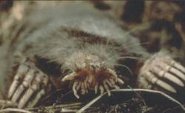 The Star-nosed Mole (Condylura cristata) has a large habitable range that is found in eastern Canada, and the northeastern upper half of the United States. The mole lives in moist lowland locations and is primarily an insectivore, feasting on invertebrates and arthropods that are small. Its large scaly feet help in its swimming, while the thick and long tail help with fat storage. The mole is about 50-60 grams (0.10-0.11 lbs), has 44 sharp teeth, and is 150-200 millimeters (7-8 inches) in length.
The Star-nosed Mole (Condylura cristata) has a large habitable range that is found in eastern Canada, and the northeastern upper half of the United States. The mole lives in moist lowland locations and is primarily an insectivore, feasting on invertebrates and arthropods that are small. Its large scaly feet help in its swimming, while the thick and long tail help with fat storage. The mole is about 50-60 grams (0.10-0.11 lbs), has 44 sharp teeth, and is 150-200 millimeters (7-8 inches) in length. Like its cousins it digs burrows and tunnels for foraging grubs, worms, and other foods, including mollusks too. Many times these tunnels will lead under-water, as an easy escape route. It digs two types – a shallow foraging tunnel, and a much deeper tunnel for protection. The mole remains active during winter months, and has been seen swimming in freezing rivers and icy streams, protected by its thick black to brown fur, which is effective at repelling water and holding in heat. Unfortunately little is known about their social behavior, however it is known that females will give birth to a litter of 4-6, and that they might be colonial. However further study is needed.
Their nose is the most unique thing. This specialized nose is unlike any other found on any mammal, and has been especially adapted to finding food in the ground.
The Star Nosed Mole (Condylura cristata) belongs to the genus Condylura, and the tribe Condylurini of the subfamily Scalopinae, which is in the family Talpidae. Talpidae has within it the desmans, many other small insectivores and of course the mole. The reason the Star Nosed Mole is listed here under all the groups is that it is the only living member of its genus, tribe, and subfamily. The family Talpidae belongs to the order Soricomorpha, which contains shrews, solenodons (of which both species are highly endangered by rats, and two are extinct), and the extinct West Indian shrews (extinct by rats which took over the niche with the arrival of Columbus). The order belongs to the superorder Laurasiatheria (containing bats, carnivores, even and odd toed ungulates, and many more), and the infraclass Eutheria (placental mammals).
Interesting Fact
The nose of the Star Nosed Mole grows unlike any other appendage on a mammal today, or known in the past. Instead of being formed as an embryo, it instead starts out as bumps, similar to those on a coast mole, however after being born the appendages split from the nose much like a banana peel.
Keywords: pink
The Star-nosed mole is listed as Least Concern (LR/lc), lowest risk. Does not qualify for a more at risk category. Widespread and abundant taxa are included in this category, on the IUCN Red List of Threatened Species
Namings for the starnosed mole
A young / baby of a starnosed mole is called a 'pup'. A starnosed mole group is called a 'labour,company or movement'.Some facts about the
Star-nosed mole
Adult weight : 0.055 kg (0.121 lbs)
Maximum longevity : 3 years
Female maturity :304 days
Male maturity : 304 days
Weaning : 24 days
Litter size : 4
Litters per year : 1
Weight at weaning : 0.03 kg (0.066 lbs)
Basal metabolic rate : 1 W
Body mass : 0.049 kg (0.1078 lbs)
Temperature : 37.85 °C (100.13 °F)

Custom Search